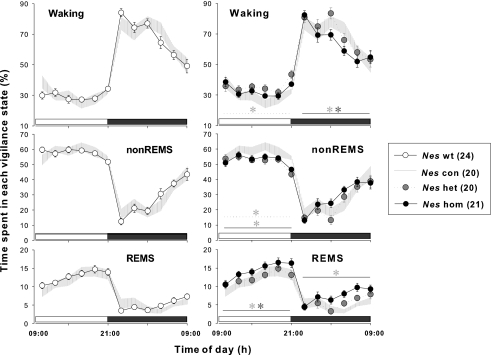Figure 1.
Time-course changes in sleep–wake patterns of corticotropin-releasing hormone (CRH)-COE-Nes mice. Data points ±s.e.m. indicate 2 h averages in time spent in waking, non-rapid eye movement (non-REM) sleep (nonREMS) and REM sleep (REMS) during a baseline recording day: open circles, CRH-COEwt-Nes (wt), n=24; hatched area, CRH-COEcon-Nes (Nes con), n=20; gray circles with dotted line, CRH-COEhet-Nes (Nes het), n=20; black circles with solid line, CRH-COEhom-Nes (Nes hom), n=21. Horizontal open bar, light period; horizontal filled bar, dark period. Two-way analysis of variance (ANOVA) among four genotypes; for waking during the light period F(3, 246)=3.13, P<0.05, during the dark period F(3, 246)=3.01, P<0.05; for non-REM sleep during the light period F(3, 246)=5.14, P<0.01, during the dark period F(3, 246)=1.71, n.s., for REM sleep during the light period F(3, 246)=4.32, P<0.01, during the dark period F(3, 246)=9.27, P<0.001. No statistical significances were found in vigilance between wild-type and control mice (left panels). Heterozygous and homozygous mice showed significant differences in between or compared with con mice, indicated by its respective line and * (right panels).

